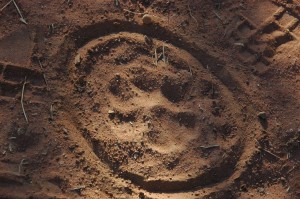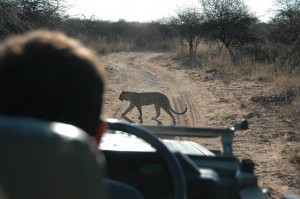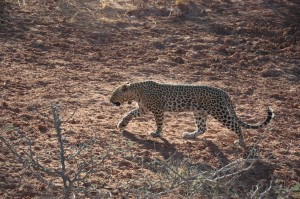Our next stop out of Etosha, was Okonjima Lodge in Namibia, which is both a lodge and a large cat rehabilitation center. It also makes a pretty good halfway point on the road from Etosha to Windhoek. It has several Jurassic Park like paddock areas with different critters in them. What I mean by paddock is a large(several thousand hectacre) natural environment with an electified fence around it(and this isnt your average sheep shocker fence either).
In the paddock areas, there are various antelope, zebra and giraffe, and the leopards live their life doing what they would do elsewhere… kill and eat things. The 5 leopards that live in one of the areas have radio collars on them, and we went out on two drives to find them. The radio collars worked like the movies, if you were within range and the guide was tuned into the leopards broadcasting channel (LBc), then a beep would be heard. The louder the beep, the closer to the animal the receiver is. The receiver was a rod with what looked like old fashioned roof antennae on them. The guide(Rohan) would turn the antennae North and listen to the beep, East and listen for the beep, West and South and repeat. Using this method, they could get an idea which way was the best way to go to find the animal. That is, if the animal is within range.
The first was in the morning, and we found our leopard after tracking it for 2 hours. In the beginning of the tracking, we couldn’t get in range of any to be able to track them. When we found her, she was smaller in size than I imagined a leopard, and she was in thick, thick bush. The second tracking session, Rohan managed to track the leopard in 8 minutes, and we were looking at a large male. This was more of the size I had imagined. I definately would not want to encounter one of these in the wild, because if you did, it would be on their terms. The animal was hard to spot, even from as close to it as we were. We had spent easily over 6 hours in Etosha trying to spot a leopard, and even with a tracking collar it had taken us 2 hours earlier. It was a beautiful animal though.
We were in luck though, Rohan was able to find a second leopard quickly nearby, this time it was a smaller female, but she was up in a tree. I had imagined leopards hiding up in larger trees with some room to change things up a bit. This tree was pretty small, and I really dont understand what she was doing up there. She got a bit disgruntled with us, and ran off into the bush. We drove away, as it the area was well known for puncturing tires. Later, we randomly ran into her again, this time she was laying underneath a small bush, I got some good shots of her. As we stood there, a small antelope called a Dik Dik approached, and she went for it, but it got away. It came back and kept making this braying noise at her, until she got annoyed and left. I guess it was letting her know that it saw her.
We visited another paddock and got to see some rehabilitated cheatahs. It was odd, because we got really close to them. Or more like, they got really close to us. Rohan explained that they had been raised by humans, and while they are wild animals, they are used to people. Which of course, also means that they will never leave the Lodge grounds.
As for how the lodge is itself, I really liked it. One could tell that alot of effort had gone into the place for a lot of years. The ‘cabin’ we stayed in was kind of like a cement bombshelter with windows. It was especially neat looking out from your bed onto a natural area with Oryx and Jackal running around.
This place has hands down had the best meals we have had on the trip yet. As with the other places they incorporated various game meats into the meal. Kudu can be good or it can be kind of gamey quite a bit like venison, Oryx seems tough and gamey, Eland is like a fat steak with good flavor.





#1 by bill helbig on November 7, 2010 - 4:09 pm
Quote
another wonderful experience…yeah! thanks for the interesting descriptions of everything. it enhances one’s imagination.. be happy..be safe…xxxooo
#2 by billis on November 7, 2010 - 8:10 pm
Quote
Was this place a private or state-run facility?
#3 by MDH on November 8, 2010 - 8:59 am
Quote
What an adventure you are having. Wild animals at your doorstep. I can’t imagine how exciting it is.
#4 by Eric on November 10, 2010 - 11:30 am
Quote
Bill: Its a private ‘reserve’ or rehabilitation center, that gets its funding through guests and donations.
#5 by Janie on September 10, 2014 - 1:46 pm
Quote
We’re a group of volunteers and starting a new scheme in our community.
Your web site offered us with valuable info to work on. You have
done an impressive job and our whole community will be grateful to you.
Trackback: Payoneer Fees
#6 by Gregpaf on May 7, 2018 - 5:24 am
Quote
?????, ????? ??? ? ?????, ?? ?????????? ??? ????????? ?????? ??? ?????????? ???????? ?????????? wordpress.
#7 by francisbc2 on July 15, 2019 - 5:59 pm
Quote
Daily updated super sexy photo galleries
http://seniordating.instasexyblog.com/?teresa
adult search extreme porn public porn tube railway porn donkey show videos tube porn adult videp free xxx live porn
#8 by cynthiaay11 on July 15, 2019 - 6:34 pm
Quote
Big Ass Photos – Free Huge Butt Porn, Big Booty Pics
http://somalishemale.instasexyblog.com/?alia
porn dirty nurses free beautiful porn chocolate thunder porn actor lesbian anal domination porn wii web browser porn
#9 by Professionalqpt on August 16, 2019 - 3:50 am
Quote
???????,??????????! .
#10 by HowardSeavy on October 30, 2019 - 3:49 am
Quote
http://healthrx.eu/ Viatsagentee
#11 by GeraldJiC on November 1, 2019 - 1:05 pm
Quote
http://healthxx.eu/ Viatsagentee
#12 by JamesBox on November 2, 2019 - 2:29 pm
Quote
http://medicex.eu/ Viatsagentee
#13 by AlbertWrale on November 4, 2019 - 1:29 pm
Quote
http://storrekuk.eu/ Viatsagentee
#14 by EliasNon on November 6, 2019 - 2:38 am
Quote
http://sinouvol.eu/ Viatsagentee
#15 by IrvingBug on November 8, 2019 - 5:20 pm
Quote
http://onlinevergleich.eu/ Viatsagentee
#16 by Joshuajat on November 10, 2019 - 7:32 am
Quote
http://agalon.eu/ Viatsagentee
#17 by Peterchork on November 18, 2019 - 3:53 am
Quote
http://pillenomgewichtte.eu/ Viatsagentee
#18 by Clintoninace on March 21, 2020 - 1:43 pm
Quote
more information buy dumps
#19 by Josephgow on May 5, 2020 - 9:16 pm
Quote
Find Out More buy dumps
#20 by Carolwaign on October 13, 2020 - 5:03 pm
Quote
??????? ?????????? ????,????? ????? ???????? ????? ??????. ?????????? ? ??????
??? ??????????
#21 by Carolwaign on October 13, 2020 - 5:10 pm
Quote
?????? ?????????? ????,????? ???????? ??? ????? ????? ??????. ?????????? ?? ????? ????
online ??????????
#22 by DorthyChark on October 13, 2020 - 7:56 pm
Quote
?????? ?????????? ????,????? ????? ??????????????. ?????????? ?? ????? ???? You want regular sex, find a sex partner for a minimum of time. Dating in St. Petersburg
?????????? ???? ??
#23 by Debraextic on October 16, 2020 - 3:12 pm
Quote
?????? ?????????? ????,????? ????? ???????? ?? ??????? ???????. ?????????? ? ?????? You want regular sex, find a partner for sex Now. intimate dating site
????? ??????? ??? ??????????
#24 by Anonymous on March 11, 2021 - 2:08 pm
Quote
??? ??????????! ? ?????? ?????????? ???? ?-?-?-?-???? ????????? ???????, ? ??????? ????? ????? ?????? ?? ? ?! ??? ?????????? ????? ?????? ??????????? ?? ?????? ?? ??????? ??????-??? ??? ??????? ???????? ?? ????? http://itissex.xyz P.S.??? ????!
#25 by Carlonam on May 15, 2021 - 7:03 pm
Quote
hydra – hydra ??????, ???????? ???????? ?????
#26 by Julianpap on June 17, 2021 - 1:41 am
Quote
????????? ?? ????. ???? ???????. ????????? ??????? ???????????? Moderator
#27 by upgrades on November 18, 2021 - 2:10 am
Quote
Los Cumbiamberos Charito La Calandria Canta https://apple.androsace.org.uk/6.html Discorpse The War Years
#28 by Orlandochazy on August 26, 2022 - 6:39 pm
Quote
???? ??????????? ?????? ???????? ?? ??? ????: ?????????, ??????????? ? ???????? (???????? ????????). ? ????? ??????????? ?????????? ?????????? ??????, ?? ????????? ????????? ???????????? ??? ???????. ??? ??????????? ???????????? ????? ?????????, ??? ??????? ??? ????? ???????? ?? ???????? ??????????. ????????? ??????????? ??? ????????????? ??? ???????? ???????? ? ???????????? ????? ???????? ????????? ????, ????????????, ?????????? ????. ???? ??????? ?????? ???? ???? ?????? ???????? ?? ????????? ?????, ?? ????? ??????????????? ???????????? ????? ??? ???????? ?????? ???’??? – ????????, ????, ?????. ?????, ??????? ??????, ??????, ????????? ???????????? ????? – ?? ?????? ????????? ????? ??? ?????????, ??? ? ?????????? ????????. ???? ?????? ????? ????????? ??? ??????? ????? ? ????????? ??????. ????? ?????????? ????????? ????????? ??????????? ????? ?????? ? ????????? ??? ??????. ?????? ??????? ???????: ??????, ???????, ?????, ???? – ??????? ?????????? ?????? ?????? ??????????? ? ????.